IJN Chin Yen: The first Japanese Ironclad

 Imperial Chinese Navy – Imperial Japanese Navy
Imperial Chinese Navy – Imperial Japanese Navy
The result of the first Sino-Japanese war in 1894 was a devastated, scuttled Beiyang Fleet, the largest fleet ever fielded by the Chinese Empire so far since the days of Zheng He. The prize which topped it all were a pair of Chinese ironclads built in Germany: The Dingyuan class. However both had been already damaged at sea during the battle of the Yellow sea, and were further damaged by a night attack b torpedo boats, one being beached to avoid sinking, and both were later finished off by Japanese field artillery bombarding directly from the inner fortifications of Heihaiwei.
These events would repeat themselves against the Russians in 1904-1905. After the Beiyang fleet scuttled itself, the ships became war prizes. However the Japanese choose to only reactivate the lest damaged of the two ironclads: the Chen Yuan (or Zhenyuan). Summarily repaired a first time in situ, then further at Port Arthur, and again at Yokosuka, she was rearmed and became IJN Chin Yen, the first Japanese modern battleship. In 1914, IJN Chin Yen was maintained as a training ship due to her age and condition but did not participated really in WW1.
Japanese strength prior to 1894
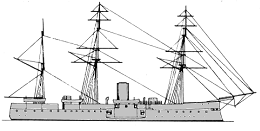 Knowing history, it’s difficult to accept that in 1890, the Chinese completely dwarved the Imperial Japanese Navy. The first however had to spread out this strength between three fleets along its long coastline. The Nanyang (southern) fleet, already blooded against the French at Shipqu in February 1885 was the second best, followed the famous Beiyang (Northern) fleet, once dubbed “the best in asia”. In 1885 indeed, it comprised at its peak 2 battleships, 8 cruisers, 6 gunboats, and 4 torpedo-boats. Compared to this, the Imperial Japanese Navy had:
Knowing history, it’s difficult to accept that in 1890, the Chinese completely dwarved the Imperial Japanese Navy. The first however had to spread out this strength between three fleets along its long coastline. The Nanyang (southern) fleet, already blooded against the French at Shipqu in February 1885 was the second best, followed the famous Beiyang (Northern) fleet, once dubbed “the best in asia”. In 1885 indeed, it comprised at its peak 2 battleships, 8 cruisers, 6 gunboats, and 4 torpedo-boats. Compared to this, the Imperial Japanese Navy had:
-Armoured corvette Ryujo (1868), British built, TS 1894 (scrapped 1904)
-Central battery ironclad Fuso (1877), british-built, refitted 1894.
-2 Armoured Corvettes class Kongo (1877), British-built (ironclads for some authors).
-2 Protected cruisers class Naniwa (1885), British-built
-3 Protected cruisers class Matsushima (1890) French built
-Protected cruiser Akitsushima (1892), Japanese-built
-Protected cruiser Yoshino (1892) British built, puchased on the stocks
-Protected cruiser Idzumi (1883), British built for Chile, purchased.
The only armoured ships were the very old Ryujo, not deployed as she was a TS, the Fuso, modernized just in time but slow, and the two Kongo and Hiei, also modernized. None had the armament or tonnage of the still fresh (barely eight years old) Chinese battleships built in Germany, along the lines of the Sachsen class, but much better armed.
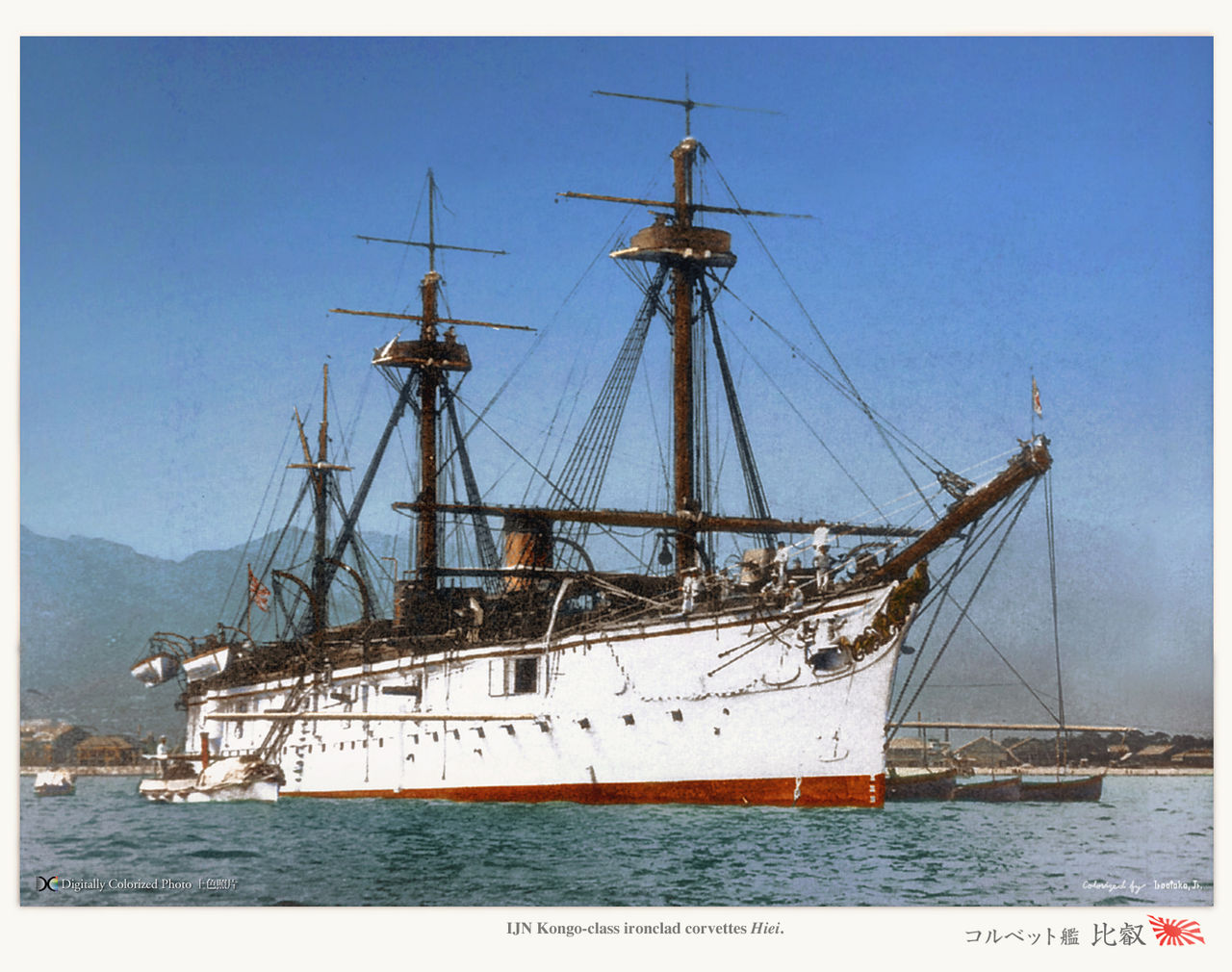
IJN Hiei, armoured corvette
History and design of the Dingyuan class ironclads
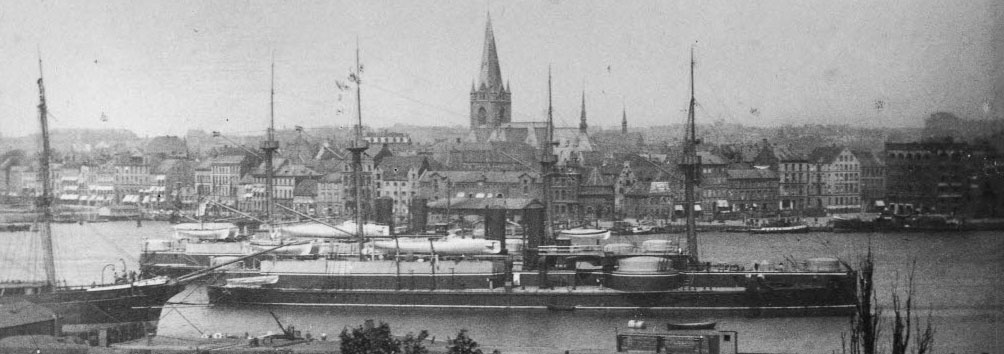
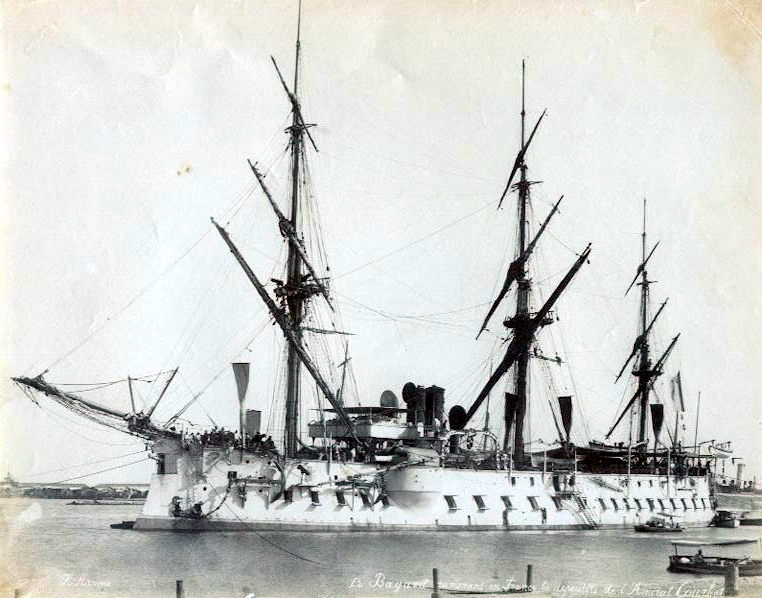
French Ironclad Bayard, flagship. The bulk of the French force threatening southern China and therefore the Nanyang fleet was initially part of the Tonkin coasts division and later joined the Far East naval division (based in Yokohama) to form Far East Squadron.
The combined force also comprised the ironclads La Galissonnière, Turenne, Triomphante, Atalante, 15 cruisers and many other ships, gunboats and auxiliaries. During the 1885 war, the Beiyang fleet failed (refused) to assist Nanyang fleet, which was not forgotten. Both ironclads had been ordered in 1880 at a time tensions both with France and Japan were high. Germany was chosen to provided these as the British government did not wanted to antagonize Russia, whereas Germany waited before delivering both ships to not antagonize France.
This was for sure quite some help as none of the Chinese fleets combined could have won over the French at that time. In 1894, the Beiyang fleet had received the ironclads plus an armoured cruiser and perceived more cruisers, making it the largest Asian fleet in operation. A veritable scare campaign started towards the Japanese, both ships were thought to act as a naval deterrence.
But provocations and an incident definitively severed the last remnants of Japanese tolerance for these ships, constrained to be maintained in Port Arthur alone which was limited.
The two ironclads had been the first major ships ordered for the renewed Beiyang fleet, a considerable expanse won by the will of the Zhili governor, Viceroy and the Minister of Beiyang Commerce, Marquess Li Hongzhang. Not only he won the support of Empress Dowager Cixi, but also resolutely bolstered the Chinese Imperial Navy, after quelling several rebellions.
The man ordered ships modelled in a way like himself, in Krupp hardened steel. Both battleships after being ordered in Vulcan in 1880, made a sensation, and immediately entered in French calculations, as they were larger, faster and better armed than any of the Far East Squadron older ironclads.
They also far outclassed the Japanese old ironclads, the 1878 Kongo class and 1877 Fuso. The Dingyuan was twice as large and carried 30 cm guns, compared to 17 cm and 25 cm on the old masted Japanese ships.
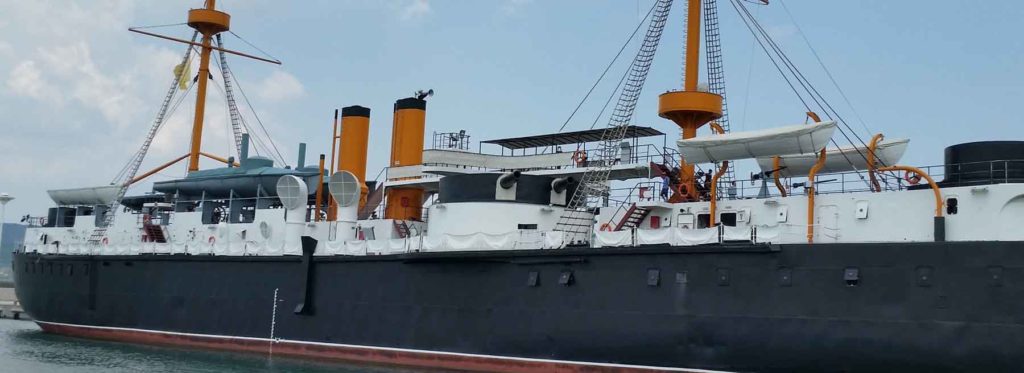
Dingyuan as reconstructed as a museum ship nowadays.
The Dingyuan and Zhenyuan displaced about 7800 tons, with a top speed of 15 knots (see the specs). Propelled by three-cylinder trunk steam engines (HTE) on two shafts, the total output was estimated 7200 ihp, with the steam coming from eight cylindrical boilers.
The lack of maintenance meant 14 knots was not even approached in 1894. In fact the ships barely cruised at 6 knots, partly because of the slower troops steamers coming from the Yalu they escorted, and partly because their captain did not wanted the risk of broking anything.
This fact allowed the Japanese fleet to surround at 10 knots the while squadron, pummelling it on both sides, whereas the total disorganization of the Chinese meant their ships often masked their (otherwise uncoordinated and poor) respective field of fire which was inefficient at best.
Main armament of IJN Chin Yen
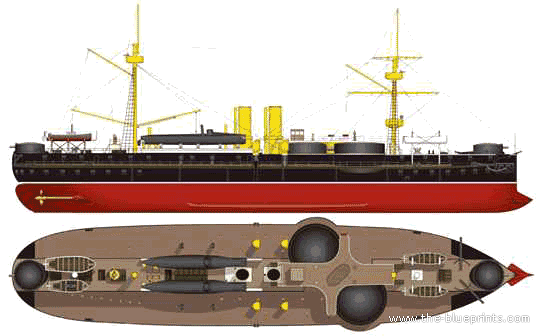
Where the Sachsen class ships has six 28 cm guns, the Chinese ironclads had four 300 mm Krupp guns in two barbettes placed in échelon (lozenge). The main armament allowed to fire a combined broadside (although disrupting the gangway structure), and forward and aft fire.
The great novelty of the design was to procure two turrets housing secondary guns with 6-in Krupp BL (Breech loading) artillery pieces, at the forward and aft ends, literally to the bow and stern. This feature was pretty unique and rarely seen elsewhere.
In addition both ironclads carried 10 3-pdr and 2-pdre QF guns to deal with other TBs. Another interesting feature was a pair of torpedo boats carried at the rear, abaft the rear mast. They were known as Dingyuan No. 1 and 2 and Zhenyuan No. 1 and 2, making the only TB presence on the Beiyang fleet.
However these were midget torpedo boats, barely 15.7 tons, armed with two 14-in torpedo tubes in the bow. They could only operate by calm sea, not usual in the north. After capture and modernization, this was changed by the Japanese (see later).
Armor of IJN Chin Yen
The original armor was left untouched by the Japanese in 1895. The main belt ranged from 10 to 14 in which was excellent, in Krupp steel, whereas the main turrets had walls 12 in thick, and the forward and aft secondary turrets had walls 2-in thick. The armoured deck had a 3-in thickness and the conning tower had 8-in thick walls.
Defeat and capture
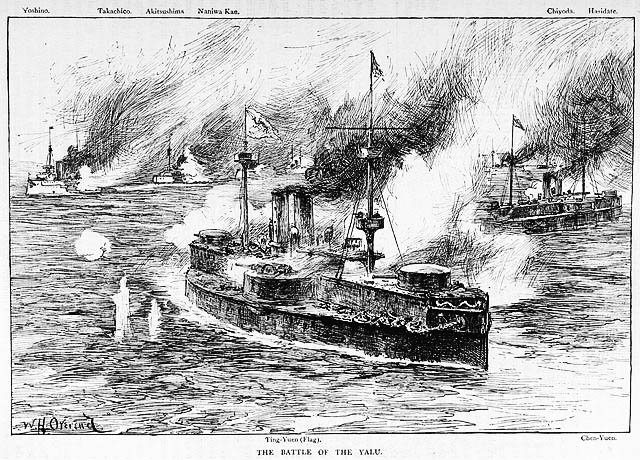
The Battle of Yalu has been a disaster, not only for the Beyiang fleet, which lost four cruisers that day, and the rest of the fleet badly damaged, but for the Chinese Imperial Navy as a whole. Indeed, remembering the 1885 refusal to help her, Admiral Li Chengmou declined to send any naval reinforcement to the northern fleet when war erupted over Korea with Japan in 1894.
The Chinese fleet at that point has been severely weakened already by internal forces: In 1888, Grand Tutor Weng Tonghe advised the Guangxu Emperor to cut all funding to the navy (and army as well) as Japan was not yet perceived as a threat whereas several natural disasters required a more urgent reallocation of the funds.
Also, despite the advices of Captain William Lang, ammunition and coal supplies dropped to a standstill, ans crews went to other occupations whereas the ships rot at anchor, without training nor maintenance whatsoever. This was compounded by the exclusion of many foreign advisors, corruption in general and Li Hongzhang’s own enemies manoeuvers at the court.
In 1894, the fleet had sunk to an all-low when the war broke out, and admiral Ding Ruchang, a cavalry officer(…) had to make due with what he had. Worst still, the Dingyuan first salvo collapsed the bridge and prevented him to led the fleet for the whole battle. The result, opposing a smaller yet well-trained, led and equipped Japanese squadron, was already written at the wall.
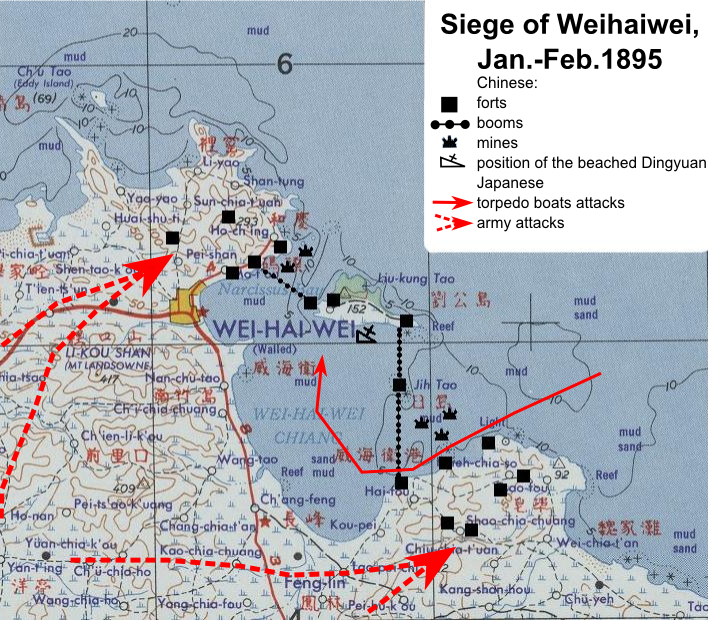
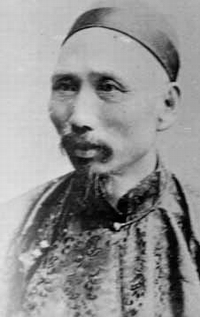 The Beiyang fleet’s survivors took refuge in port Arthur where some repairs could be done.
The Beiyang fleet’s survivors took refuge in port Arthur where some repairs could be done.
But the Chinese Imperial army performed equally as poorly on land and Japanese troops, Prussian trained, soon arrived to the gates of the fortress port, which was besieged. Fearing its impending fall, Ding Ruchang ordered the fleet to leave for the southern port of Weihaiwei, also well fortified.
However with resources still lacking, little could do to improve the situation and in the end, the fleet was trapped and cornered when the Japanese succeeded in taking all fortifications and turn all their field guns and artillery against the Beiyang fleet.
After the fleet surrendered, the Japanese contemplated the fleet which was once “the strongest in Asia”. The battle of Weihaiwei had lasted from 20 January to 12 February 1895. This was the last and most decisive battle, and action of the first Sino-Japanese War. The prize were 16 warships, including the ironclads Dingyuan and Zhenyuan, the protected cruisers Jingyuan and Pingyuan plus 13 gunboats and TBs.
For the Dingyuan the second torpedo boat attack on the night of February, 4, was the most devastating: On this night a second torpedo-boats atack took place in three squadrons and the torpedo attack was preceded by a diversion of two small gunboats, Chokai and Atago.
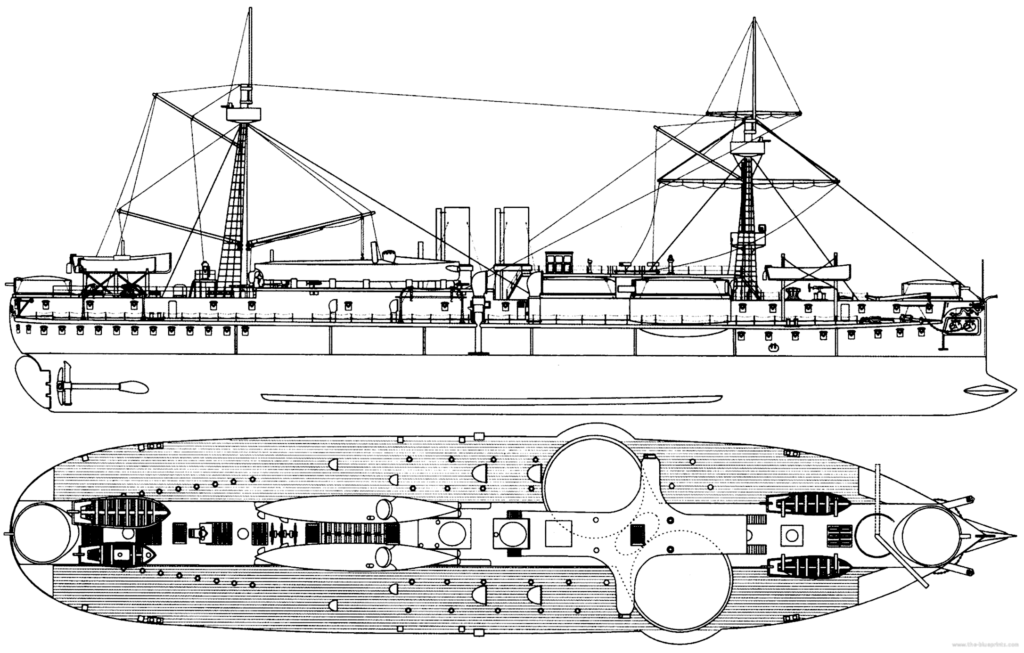
Very large blueprint of the Dingyuan class in Chinese service
Four IJN TBs discharged eight torpedoes and two were lost during the action, because of a boilers explosion and another ran aground near the eastern forts, and was finished off by the Chinese artillery. Dingyuan was reported hit and slowly sank, whereas Zhenyuan’s captain was forced to beach her to avoid her sinking completely.
On 9 February, Zhenyuan faced a third attack, this time with more substantial ships, and scored a hit on the cruiser Itsukushima. Dingyuan was lost and Admiral Ding decided to scuttle the ship, and a wave of suicides followed until 12 February.
After the surrender the next day, the Japanese combined fleet entered the port to assess the Beiyang Fleet’s damage and inspect the vessels. Zhenyuan was declared to be in salvageable condition. Only her hull’s bottom has been damaged when beached and she was seized as a war prize.
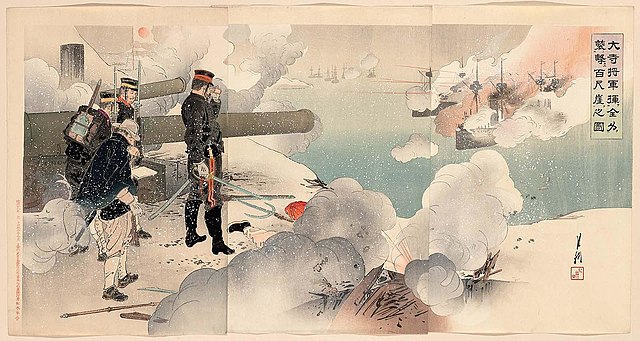
General Major Odera Yasuzumi commanding the artillery at Weihaiwei (Ogata Gekko).
The Chin Yen in action
Recovering the ship took time: The Japanese used support vessels and divers to repair what they could and refloat the ship eventually. Saikyō Maru, badly damaged once at the Battle of the Yalu River, has been repaired in between, and was used to two the Zhenyuan to Port Arthur here facilities would allow to repair her more extensively.
After repairs were done, notably in the engine rooms, IJN Chin Yen was declared seaworthy to some extent and as officially commissioned into the Japanese Navy. The ceremony happened on 16 March and she was officially renamed Chin Yen, which was the Japanese version of her original name. Nevertheless she was drydocked and temporary repaired from April until June.
Damage was inspected closely and later drawn lessons that were incorporated in proper Japanese designs. The main observation was that side armor needed to be strengthened rather than deck armor. This was merely linked to the close range (2000-3500 m) of the engagements of that time.
On 5 July, Chin Yen sailed to Japan, as the largest vessel in the Japanese Imperial fleet. She became its de facto capital ship, and steamed for a triumphal tour of archipelago, the very embodiement of the victory over the Chinese. After Nagasaki until 16 July, she crossed the Seto Inland Sea, stopped in Hiroshima, and afterwards in Kure and Kobe. IJN Chin Yen final destination was Yokohama, reached on 28 July.
From there she joined the Yokosuka Naval District and was immobilized for a substantial rebuilding, and permanent repairs, never done properly since Port Arthur. The main battery stayed unchanged bu modern a fire-control directors were installed, whereas the secondary battery was modified and modernized.
Rearmament of IJN Chin Yen:
Instead of the two old breech-loading short-barrel Krupp guns, the ship received four modern QF 6-in/50 Vickers guns, installed in the former forward turret, and the remainder three in single positions under masks, one in place of the aft turret, and two either side in sponsons, abaft the rear mast.
In addition, the light artillery was also completely new, with two 6-pdr (57 mm) guns placed on the lower hull sides (hull recesses decks) and the others eight 3-pdr (47 mm), with shields, on the decks, four aft, two immediately rear to the funnels, and two on the forward deck. A blueprint of the Chin Yen which originated in the jane’s fighting ships 1904, shows one 47 mm (1.85 inches) on each mast fighting top, so ten in all, and two 37 mm (1.46 inches) on the recess decks instead of the larger 6-pdr. The figures here are from Conway’s.
Service until the Boxer war
The Meiji Emperor visited the ship at Yokosuka on 25 November 1896 after another triumphal tour of Japan when the ship has been refitted and repainted white. However by that time, Japan just waited for the Fuji class battleships to enter service and IJN Chin Yen was reclassified as a second rate battleship. She would served with the Combined Fleet until 21 March 1898. By that time she had been versed as the flagship of the Reserve Fleet and for the following years, she multiplied cruises in Japanese waters, visiting many ports.
As the Boxer Rebellion broke out in China, she was sent to join the Eight Nation Alliance and covered ground operations during the Battle of Tientsin, putting an end to the siege by the Boxers.
The Russo Japanese war
Battle of the Yellow sea
After 1901, IJN Chin yen returned as flagship of the reserve fleet, spending periodic time at anchor. However soon, situation deteriorated over the control of Korea, tensions rose with Russia. In 1904 it broke out, and the Japanese on 8 February launched a surprise night torpedo-boat attack on the Russian First Pacific Squadron in Port Arthur, exactly what they did against the Beiyang fleet in Weihaiwei. Chin Yen by that time served with the 5th Squadron, 3rd Fleet, Vice Admiral Kataoka Shichirō rausing his mark on her mast. She served with the three other veterans of 1894-95, the Matsushima-class cruisers. They sailed from Sasebo on 6 February in preparation for the war and stayed in reserve, ready to intervene at sea.
The Blockade of Port Arthur
They were called at least to enforce the blockade of Port Arthur, which represented a large area. Desperate to make a breakthrough, the Russian sortied and this led to the second Battle of the Yellow Sea on August, 10.
Chin Yen saw action under Admiral Tōgō Heihachirō and her fire contributed to repel the Russians, force them back to port. During this battle she apparently scored several hits in exchange of two hits without serious damage. The blockade resumed and the Japanese combined fleet shelled Russian positions on 6 March. Chin Yen then shelled Vladivostok with other ships, firing on another Russian squadron during forty-minutes, with few results.
Battle of Tsushima
On 27–28 May 1905 the Russian Second Pacific Squadron was made if the former Baltic Fleet, and made a long trip to Asia. Tōgō intercepted this fleet off Tsushima Strait. Chin Yen with the 5th Squadron was posted at the line of battle’s tail, ready to take on the back Russian line.
IJN Chin Yen, with others, sank the Kamchatka and badly damaged the Knyaz Suvorov. The following day, after all appeared wrapped up, the 5th Squadron ships made a large sweep to search and destroy the remainder of the Russian fleet still in action.
She also escorted seven surrendered warships to Japanese ports, to be taken as war prizes. The bounty was even more larger than at Weihaiwei.
Chin Yen led the 5th Squadron to Tsushima on 20 June. At last, the old ironclad was placed in drydock to be refitted in Kure. She was assigned to the Ōminato Guard District, northern Honshu. However she was chosen to participate in a late action: The Sakhalin landings on 4 July 1905.
The war ended on 5 September. IJN Chin Yen escort the cruiser Bayan, scuttled at Port Arthur, but raised and salvaged, then conducted to a Japanese yard for permanent repairs. Chin yen also participated in the 23 October victory review, for her last major event in the active fleet.
There was a parade of captured Russian warships, and the Chin Yen and two other former Chinese ships making the world’s largest naval spoils displayed ever shown to a public. As a veteran of two wars, the Chin Yen was revered.
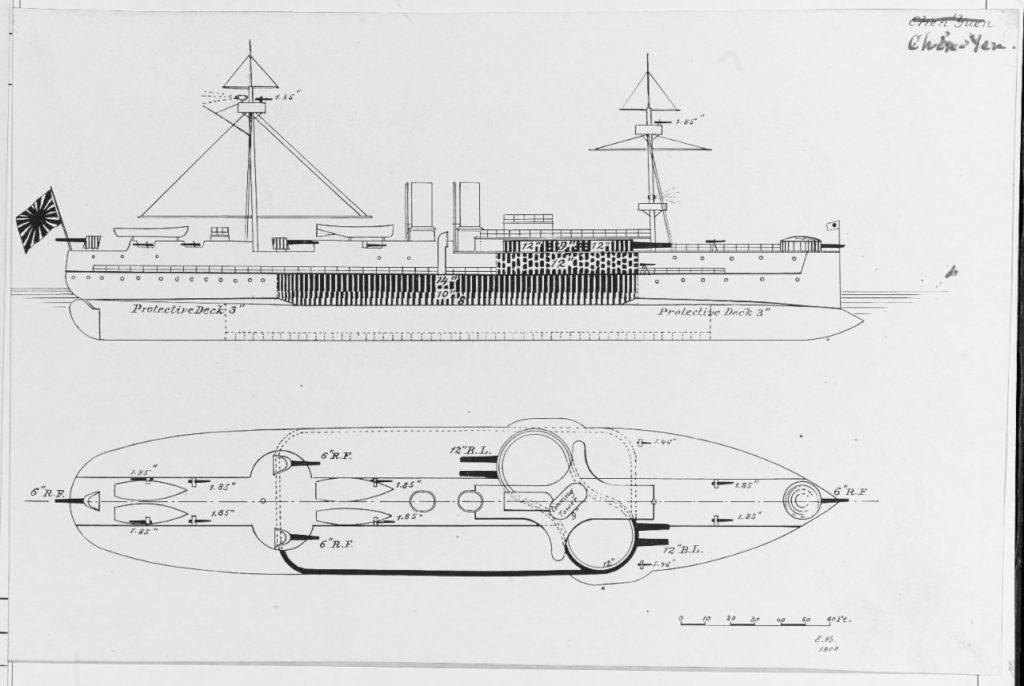
Chin yen as modernized by the Japanese.
Later years
IJN Chin Yen was reclassified as a first-class coastal defense ship on 11 December. She was now indeed too slow, old and obsolete to join any action with the active fleet. During 5.5 years, she was also used as a training ship for naval cadets and took part in several training exercises with the fleet, culminating with the October-November 1908 Imperial review in presence of the the Emperor. By April 1911 she was decommissioned, replaced by IJN Itsukushima as a training vessel.
IJN Chin Yen was disarmed and used as a target ship. The new cruiser Kurama notably fired on her in late 1911. Her hull was sold to ship breakers in April 1912 and the sell funds were partly used to create the grand hall of the Naval Academy Etajima (Hiroshima).
Her anchors were taken apart and preserved from 1896, later deposited at Ueno Park (Tokyo) as a victory monument after WW1. This caused an outrage in China and the Chinese nationalist government later obtained their return, granted by the American occupation authority in May 1947. They were displayed at the naval academy in Qingdao. After the 1949 communist victory they were seized an later transferred to the PLAN Military Museum in Beijing.
Read More/Src
Chamberlin, William Henry. Japan Over Asia, 1937
Jane, Fred T.The Imperial Japanese Navy (1904)
Kodansha Japan An Illustrated Encyclopedia, 1993, Kodansha Press, Tokyo
Lone, Stewart. Japan’s First Modern War: Army and Society in the Conflict with China, 1894-1895
Paine, S.C.M. The Sino-Japanese War of 1894-1895: Perception, Power, and Primacy
Warner, Dennis and Peggy. The Tide At Sunrise, 1974
Wright, Richard N. J.The Chinese Steam Navy 1862-1945
Conway’s all the world’s fighting ships 1865-1905
http://sinojapanesewar.com/PortArthur.htm
http://sinojapanesewar.com/weihai.htm
//en.wikipedia.org/wiki/Nanyang_Fleet
//en.wikipedia.org/wiki/Beiyang_Fleet
//en.wikipedia.org/wiki/Far_East_Squadron

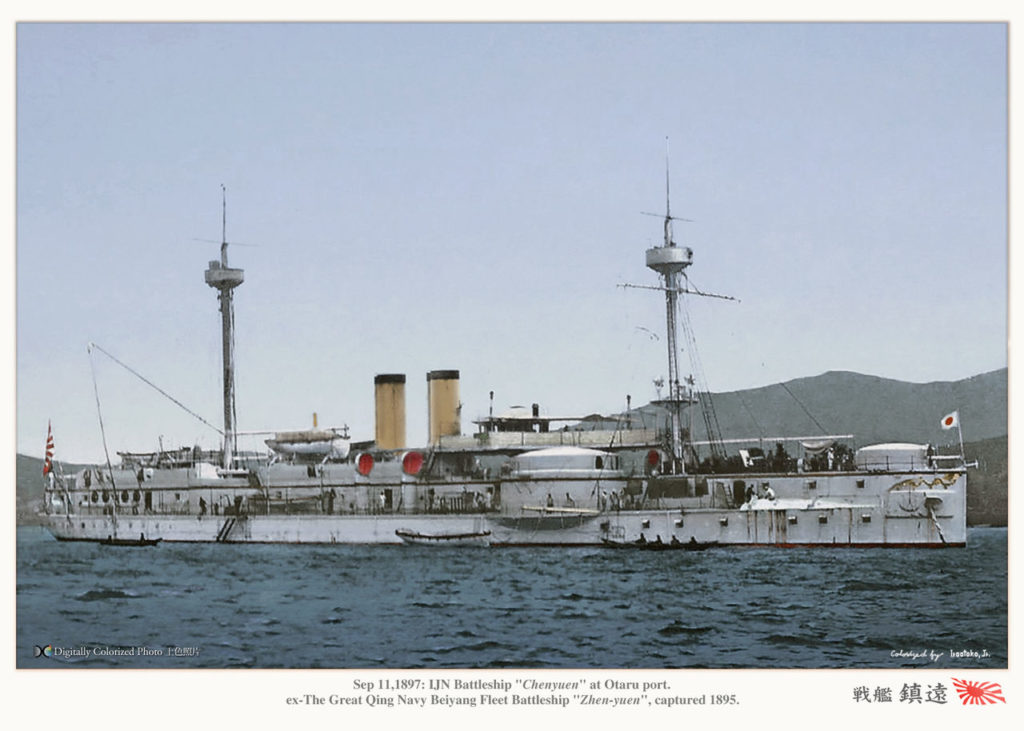
 Latest Facebook Entry -
Latest Facebook Entry -  X(Tweeter) Naval Encyclopedia's deck archive
X(Tweeter) Naval Encyclopedia's deck archive Instagram (@navalencyc)
Instagram (@navalencyc)





 French Navy
French Navy Royal Navy
Royal Navy Russian Navy
Russian Navy Armada Espanola
Armada Espanola Austrian Navy
Austrian Navy K.u.K. Kriegsmarine
K.u.K. Kriegsmarine Dansk Marine
Dansk Marine Nautiko Hellenon
Nautiko Hellenon Koninklije Marine 1870
Koninklije Marine 1870 Marinha do Brasil
Marinha do Brasil Osmanlı Donanması
Osmanlı Donanması Marina Do Peru
Marina Do Peru Marinha do Portugal
Marinha do Portugal Regia Marina 1870
Regia Marina 1870 Nihhon Kaigun 1870
Nihhon Kaigun 1870 Preußische Marine 1870
Preußische Marine 1870 Russkiy Flot 1870
Russkiy Flot 1870 Svenska marinen
Svenska marinen Søværnet
Søværnet Union Navy
Union Navy Confederate Navy
Confederate Navy Armada de Argentina
Armada de Argentina Imperial Chinese Navy
Imperial Chinese Navy Marinha do Portugal
Marinha do Portugal Mexico
Mexico Kaiserliche Marine
Kaiserliche Marine 1898 US Navy
1898 US Navy Sovietskiy Flot
Sovietskiy Flot Royal Canadian Navy
Royal Canadian Navy Royal Australian Navy
Royal Australian Navy RNZN Fleet
RNZN Fleet Chinese Navy 1937
Chinese Navy 1937 Kriegsmarine
Kriegsmarine Chilean Navy
Chilean Navy Danish Navy
Danish Navy Finnish Navy
Finnish Navy Hellenic Navy
Hellenic Navy Polish Navy
Polish Navy Romanian Navy
Romanian Navy Turkish Navy
Turkish Navy Royal Yugoslav Navy
Royal Yugoslav Navy Royal Thai Navy
Royal Thai Navy Minor Navies
Minor Navies Albania
Albania Austria
Austria Belgium
Belgium Columbia
Columbia Costa Rica
Costa Rica Cuba
Cuba Czechoslovakia
Czechoslovakia Dominican Republic
Dominican Republic Haiti
Haiti Hungary
Hungary Honduras
Honduras Estonia
Estonia Iceland
Iceland Eire
Eire Equador
Equador Iran
Iran Iraq
Iraq Latvia
Latvia Liberia
Liberia Lithuania
Lithuania Mandchukuo
Mandchukuo Morocco
Morocco Nicaragua
Nicaragua Persia
Persia San Salvador
San Salvador Sarawak
Sarawak Uruguay
Uruguay Venezuela
Venezuela Zanzibar
Zanzibar Warsaw Pact Navies
Warsaw Pact Navies Bulgaria
Bulgaria Hungary
Hungary

 Bundesmarine
Bundesmarine Dutch Navy
Dutch Navy Hellenic Navy
Hellenic Navy Marina Militare
Marina Militare Yugoslav Navy
Yugoslav Navy Chinese Navy
Chinese Navy Indian Navy
Indian Navy Indonesian Navy
Indonesian Navy JMSDF
JMSDF North Korean Navy
North Korean Navy Pakistani Navy
Pakistani Navy Philippines Navy
Philippines Navy ROKN
ROKN Rep. of Singapore Navy
Rep. of Singapore Navy Taiwanese Navy
Taiwanese Navy IDF Navy
IDF Navy Saudi Navy
Saudi Navy Royal New Zealand Navy
Royal New Zealand Navy Egyptian Navy
Egyptian Navy South African Navy
South African Navy






























 Ukrainian Navy
Ukrainian Navy dbodesign
dbodesign